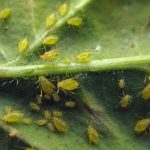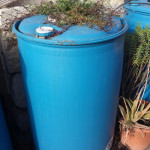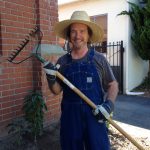Organic pest control
 Bugs in your garden are an indicator, not a “problem” to be fixed. They’re an indicator of an imbalance in your overall garden system.
Bugs in your garden are an indicator, not a “problem” to be fixed. They’re an indicator of an imbalance in your overall garden system.
It’s kind of like the indicator light on the dashboard of your car — when the red light flashes, it’s not the lightbulb that needs to be fixed, instead you need to fix the underlying problem that the light is telling you about.
For 11 years we ran the Community Garden at Holy Nativity organically. We didn’t use pesticides or pest treatments, we didn’t reach for sprays — whether purchased or homemade, organic or not. Instead we took a holistic approach.
Realize that any pest spray, even the organic or homemade ones, is an attempt to kill something in the ecosystem. At the Community Garden at Holy Nativity, we listened to Bill Mollison’s salty advice that “you don’t have a snail problem, you have a duck deficiency.” Rather than trying to eliminate something in our ecosystem, we tried to boost other elements within the system, to empower the system to reach its own balance.
When there was a pest “problem” we realized it was an opportunity to observe and learn more about the Garden as a whole. Green aphids on the tree collards, powdery mildew on the squash leaves — that pest “problem” was an invitation for us to observe what was going on for the plant. What were its surroundings like? How were are we doing at matching the season? How was the water? How was the soil?
Science is now establishing that when a plant is in stress, it sends biochemical signals out to the wider environment which attract a response from insects and other plants (probably from fungi and bacteria too, however the scientific study didn’t say that). I like to think of these signals like the plants calling out to the insect population, crying out “I’m done, it’s time, come help me become compost.” The insects respond by flocking to the plant and attacking. When you understand the plant/pest relationship like that, you realize that sprays of any kind are really the wrong approach, brought in far too late.
I’m not saying that Peter and I never tried to save plants that were struggling. Certainly we did. But the tools we used were far different from sprays or powders.
Here are some of our favorites:
1) Observation
Observation — or what one landscape architect taught us to think of as “the chair exercise” (take a chair and sit in your garden to observe what nature is doing) — was always the first on the list. You could think of this like diagnosis, or taking the gardens pulse, or simply listening to what the garden had to tell you.
Observation would include which plants or suffering, were they all of the same plant family, were other plants of the same plant family suffering elsewhere in the garden? How was the soil in the spot where the plants were suffering, was it compacted, could I see visible organic material? What did the one-finger test reveal, was the soil dry, or overly wet? How densely planted was the spot where the plants were suffering, were plants growing into each other, was there room for airflow? How had the weather been lately, and how well was the suffering plant matched to the current season of the year? How strictly had we been adhering to our crop rotation, were there plants that were incompatible as companion plants, which weeds were thriving in the area?
It’s kind of like taking your dog to the vet. The dog can’t speak English, but in his own way the dog is probably telling you a lot about what’s wrong — if you slow down and observe.
2) Seasonality
In our year-round vegetable gardens here in Southern California, we can grow almost anything we want to, the catch is: are we growing it in the season that it likes to grow in?
For instance, in the middle of January tomatoes won’t thrive, no matter what you do. As the weather warms up around Memorial Day, the broccoli family (broccoli, cauliflower, kale, collards, brussel sprouts, kohlrabi) gives up and says “I’m done, please help me become compost,” inviting in all kinds of garden pests, usually aphids and mildew. As summer shifts into autumn, the squash family says “I’m done, time to become compost,” and succumbs to powdery mildew — along the coast, this can happen as early as August, especially if you’ve been watering its foliage.
A plant which is at the end of its season seeks to become compost — so it is fruitless to try to “treat” the pest invasion, and futile to hope of somehow “saving” the ailing plant. Instead, we would make space for new things in the garden. We would remove the ailing plant and put in something new that would thrive. If it wasn’t yet time for the next season’s plants, we would put in a cover crop of legumes.
3) Soil
If your seasonality was okay, then your answers likely lay in the soil. When we were growing vegetables year-round for 11 years, we had to perpetually be building the soil. Any stumble in that soil building, any imbalance that arose, would eventually be seen in the plants.
We would add live, homemade compost every time that we shifted crops from one season to the next. We used a crop rotation system to keep soil nutrients flowing, and also to help cut the life cycle of soil-borne pests and plant diseases.
In my observation, it seemed like compost “evaporated” when the weather was warm and garden soil baked in the sun. I’d add compost, and a few weeks later you couldn’t see any sign of it — the soil looked compacted and there was little visual evidence of organic matter. I did some research and found that there is science to support this: the breakdown of organic material does occur more quickly when soil temperatures increase. That means that our job of enriching the soil to vegetable-garden standards becomes all that more intense during the summer months (and it means that with climate change, we will have to focus on this all the more intently!)
What this boils down to is: try top dressing with rich, live, homemade compost around the ailing plants, and water it in.
4) Worm castings
Anecdotal evidence says that worm castings behave like a “systemic” fertilizer, and can discourage pests.
I use powdered worm castings like an “energy drink” for the garden. I mix the castings into the top half-inch of soil and then water deeply. Sometimes this helps the plant grow more lustily, thus outgrowing the nibbling of the pests.
5) Deep watering
Particularly at this summery point in the year, when the overall temperatures are higher, soil evaporation occurs much more rapidly. We might water the garden occasionally and think that was enough, but sometimes that watering action is barely penetrating the surface.
Take a look at the surface of your soil. Is it tight and sandy? When you put water on it, does the water bead up and roll away, or does it soak in? Do the one-finger test to understand the soil moisture levels deeper in your soil where the plant roots are.
Some of the techniques I use include building a soil moat around the plant to contain the water (so that it will stay near the plant rather than rolling off) and then deep-watering inside that moat. Often I would attach a small hose-end sprinkler, and let it run at low flow for a long period of time while I did other garden chores.
6) Identify
It’s important to know what kind of critter you’re looking at.
Get a good bug book (Insects of the Los Angeles Basin by Charles Hogue is on my shelf, as well as Rodale’s/Barbara Ellis’ Organic Gardener’s Handbook of Natural Insect and Disease Control), or use eNature.com or Bryant’s butterflies webpage. Not all bugs are “bad.” In fact every critter has its place in the ecosystem. Learn how to identify the good bugs, too, such as ladybug larvae, parasitic wasps, and lacewings.
When you have an imbalance in your ecosystem (a.k.a. a “pest problem”), that may mean that you have a deficiency of whatever eats that bug. Maybe your garden needs more lizards or more spiders to bring things back in balance.
7) Beneficial insects
Every time you reach for a spray, even the organic or homemade ones, you are killing something. Often times these sprays are broad-spectrum killers, and will kill the good bugs as well as the ones you thought you were targeting. As garden stewards, we tried to encourage the beneficial insects to call our garden their home.
Beneficial insects would include the pollinating insects, but also predatory insects which feast upon the bad bugs.
At the Community Garden at Holy Nativity, we surrounded the Garden with “working flowers,” flowers that were known to attract beneficial insects or provide them with places to rear their young. In the early days of the Garden, we populated the space by bringing in supplies of ladybugs and decollate snails (we didn’t bring in lacewings, but that would be a good idea).
Then we tried to take care of these new critters within our ecosystem: we avoided using sprays, which would have wiped them out.
8) Advance planning
When you are in the middle of a pest invasion, you probably don’t want to hear this, but the time for dealing with your pest “problem” was probably back when you planted the plant.
First of all, where did you get the plant? Did you get it from a big-box store where they don’t take care of the plants very well? Did you plant a variety which is known to cope with your local situation, for instance did you choose a heat-tolerant tomato or a bolt-resistant lettuce? If your vegetable plant came from a six-pack, when you planted it did you just plug the little square into the hole, or did you scruffle the roots to encourage them to spread out into the soil? (At planting time at the Community Garden at Holy Nativity, we would to add mycorrhizal powder into each planting hole.) Before you planted this plant, had you enriched the soil with the very best compost you could find? Did you plant this plant in a space in the garden “where I always plant my tomatoes,” or did you choose a spot in which you hadn’t grown that kind of plant or its plant-family cousins for three to four years? When you originally planted, did you plant companion plants alongside (such as cilantro alongside broccoli-family plants) – the companion plants often confuse and dissuade pests. As you watered that plant throughout its lifetime, did you remember to “water the soil not the plant“? When you planted, did you adhere to best practices in plant spacing, or did you plant too closely together so that the leaves could not get enough air, or enough sunlight? If you are growing in a container, was the container large enough for the root ball, was the “top bigger than the bottom” — in other words, was the container size larger than the eventual mature size of the visible foliage?
9) Replacement
Oftentimes in our vegetable gardens, the answer isn’t fiddling around trying to treat the pest situation, but instead replacing the plant.
Perhaps it is time to move to the next season’s plants in your crop rotation. Perhaps it is time to plant an intensive batch of soil-building legumes. You probably don’t want to hear me say “give up,” but if your plant is truly intent upon becoming compost, if it is truly unhappy in this time and place, then a prolonged effort to try to keep it going isn’t the best use of your gardening time or precious urban garden space. Part of the role of garden steward includes acceptance of Mother Nature’s natural cycles of death and decay.
In our understanding, killing off insect populations which were just doing the job that the plant had called them to do, isn’t the way to foster wholeness. It is our understanding that efforts to extract single populations out of the overall system are futile and detrimental. Instead, we see ourselves as nurturers of the overall system, particularly the soil system.
Humanity has treated our soil so very poorly, and as a culture we are slow to climb back toward the understanding of wholeness. Yet the cutting edge of soil science reveals that diversity is very important, and scientists do not yet understand it fully. We holistic organic gardeners are indeed exploring the new frontier.
As a holistic organic gardener, you are stepping into the role of shepherding a tiny slice of the ecosystem toward greater diversity and greater wholeness. Our approach has been to add more and more diverse elements to our ecosystem. We observe what Is and what might emerge. And we surrender to the amazing power of Mother Nature, by trying to work alongside Her rather than fight Her.
Resources:
- VegGardens365 – my free app gives you seasonality information, recommended garden spacing and some notes about companion planting
- Learn more about soil in my book, The Secrets of Soil Building
- Learn more about watering in my book, Water Wisdom. And watch my video on Watering Your Garden (6:20).
- My Vegetable Crop Rotation Wheel shows you a plug-and-play method for managing your garden crop rotations
- If you’re gardening in containers, check out my book Food from a Flowerpot


